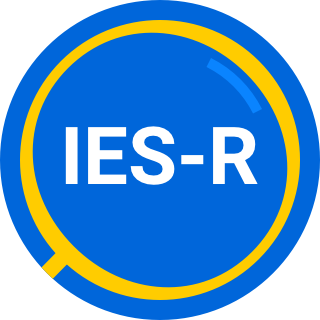Since the questionnaire relies on client self-report, all responses should be verified by the clinician, and a definitive diagnosis is made on clinical grounds taking into account how well the client understood the questionnaire, as well as other relevant information from the client.
The IES-R is not a diagnostic or screening tool for PTSD (posttraumatic stress disorder); rather, it relies on a patient's own report of symptoms and is used to gauge response no sooner than two weeks after a traumatic event, as well as to evaluate recovery.
Description
The IES-R is comprised of 3 subscales representative of the major symptom clusters of post-traumatic stress: intrusion, avoidance, and hyperarousal (American Psychiatric Association 1994). The intrusion subscale includes 8 items related to intrusive thoughts, nightmares, intrusive feelings, and imagery associated with the traumatic event. The avoidance subscale includes 8 items related to avoidance of feelings, situations, and ideas. The hyperarousal subscale includes 6 items related to difficulty concentrating, anger and irritability, psychophysiological arousal upon exposure to reminders and hypervigilance.
The IES-R is a revised version of the Impact of Event Scale (Horowitz 1979) and was developed as the original version did not include a hyperarousal subscale. IES-R responses were also modified so the client was requested to report on the degree of distress rather than the frequency of the symptoms.
Reliability, validity and sensitivity to change: Test-retest reliability (r = –0.89 to 0.94) and internal consistency (Chronbach’s α) for each subscale (intrusion = 0.87 to 0.94, avoidance = 0.84 to 0.97, hyperarousal = 0.79 to 0.91) are acceptable (Creamer et al 2003). IES-R scale scores have also been found to have moderate to strong correlations with one another (r = 0.52 to 0.87) (Beck et al 2008). Correlations have been found to be high between those of the IES-R and the original IES for the intrusion (r = 0.86) and avoidance (r= 0.66) subscales which supports the concurrent validity of both measures (Beck et al 2008).
Commentary
The indications for using the IES-R remain largely similar to those of the original IES. The IES has been recommended for use as a measure of subjective distress in clinical guidelines such as the NSW Government Guidelines for the Management of Acute Whiplash). Similar to the IES, the IES-R is a valid measure of post-traumatic stress symptoms and is useful to monitor symptoms as well as to track progress with interventions. When compared to the original version, the key strength of the IES-R is that it correlates better with DSM-IV criteria for PTSD through the inclusion of the hyperarousal subscale (American Psychiatric Association 1994).
Physiotherapists are commonly involved in the care of individuals following a traumatic event such as a motor vehicle accident. In this area, it has been recommended that all three symptom clusters be considered (Buitenhuis et al 2006). Further, there is evidence suggesting a relationship between increased hyperarousal symptoms with persistent pain and disability in chronic whiplash (Sterling et al 2003).
There has been some evidence to suggest the IES-R can discriminate between individuals with and without posttraumatic stress disorder (PTSD) (Beck et al 2008). However, there is insufficient evidence to support the IES-R as a diagnostic tool as well as conflicting evidence regarding its use as a screening tool for PTSD (Creamer et al 2003, Beck et al 2008). As with the original IES, a diagnosis of PTSD cannot be made on the IES-R alone and alternative measures should be considered if this condition is suspected (Weiss and Marmar 1997, Beck et al 2008).
Unfortunately, the IES-R does not have established cut-off points to suggest grounds for psychological referral as does the IES (scores of 26 or more out of a possible 75). There has been several cut-off values suggested for a probable diagnosis of PTSD ranging from 22 to 24 in individuals with substance use disorders (Rash et al 2008) to 33 from a possible 88 in Vietnam veterans (Creamer et al 2003). However, these cut-off values have been based on specific population groups and also relate to the raw sum of scores. As both measures were intended to provide an indication of a general level of distress related to an event and not to diagnose PTSD, cut-off points seem inappropriate. It would seem unlikely the decision to provide psychological referral would be based on the IES-R or IES alone and rather the IES-R is a tool which may aid the clinical reasoning process.


